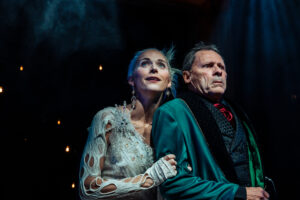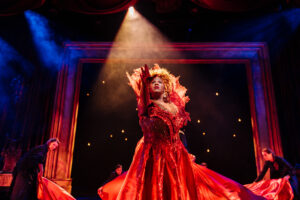Not Your Average Christmas Carol
Charles Dickens published A Christmas Carol in 1843. Its popularity has continued for almost 200 years now, and shows no sign of waning. What is often underplayed in adaptations is part of the original subtitle: Being a Ghost Story of Christmas. In the Rabbit Room Theatre’s original adaptation of the novella, the spirit world and ghostly nature of Scrooge’s visitations are emphasized in a delightful fashion. The play opens not in London, but in the spirit world as the spirits judge the dead. After several are condemned or excused (keep your ear out for references to characters from other Dickens works), Jacob Marley is brought forward. The following interaction between Scrooge’s old partner and the spirits sets up the familiar plot and introduces the ensemble of unnamed spirits who will remain on stage for the rest of the play. The interaction of these spirits with Scrooge, their discussions of him and reactions to the events of the play give a flexible and entertaining ability to tie in Dickens’ great narrative lines without the constraints of a formal narrator. Despite this alteration, there’s no feeling of gimmick or unnecessary revision; it’s just a way to better adapt the story to the stage. I’m familiar with the story and found this added a freshness. My younger sister who accompanied me to the show had never read or seen A Christmas Carol, and she had no trouble following the story.

One aspect of the play that playwright A. S. Peterson mentioned several times in the MCR interview (Playwright A. S. Peterson on “A Christmas Carol” – The Music City Review) is the use of choreography and movement in the show. Elyn Collier’s choreography is excellent. Sometimes it’s dance, but much of the time it is somewhere between dance and normal movement. There are notable individual moments: when Scrooge and his past younger selves all move in unison, and my personal favorite at Fezziwig’s party. At the peak of merriment, the cast freezes on stage, and Scrooge and the Ghost of Christmas Past walk among them speaking about them. While being discussed, the characters move in slow motion, continuing their dancing or arguing or laughter, and then freeze again as Scrooge moves on to the next group. The play has no idle or wasted movement, and the entire cast performs Collier’s constant choreography with skill.

In the original story the Ghosts of Christmas Past and Yet to Come are genderless, and Christmas Present is described like Father Christmas, bearded and dressed in green robes. In this adaptation the ghosts are played by women. Ruthy Berends is the Ghost of Christmas Past and Yet to Come. Petite and pale with white-blond hair, her looks work perfectly with her charmingly ethereal Christmas Past, and her jerky, pained movements as the ghost of Christmas Yet to Come is lurching and creepy. Probably because 21st century film has made all dark hooded figures remind us of Black Riders and Dementors, the costume of the deathly future is all white, skeletally glistening with silver metal. The one noticeable change in this adaptation is the gender-swap of the Ghost of Christmas Present, and I absolutely love it. Jennifer Whitcomb-Oliva plays the role, and (as happens every time I review a show she’s in) I have to emphasize what an amazing actress she is. Her rich voice gives all the heartiness of Christmas without annoying ho-hoing, and she moves from cheerful joy to stern reactions to Scrooge’s hatefulness with otherworldly plausibility. Her costume is glamorous, a vibrant red dress with an impressive wig, and the red cloth used as her robe works for the familiar Christmas color and as a bloody emphasis on the emaciated children Ignorance and Want. This ghost has always been the most difficult to do successfully, and here it was pulled off magnificently.

Matt Logan is the director and scenic and costume designer, and he does a marvelous job. The stage is simple, a massive golden gilt picture frame filling the center, through which most of the characters enter and leave, with a small dramatically lit room at the very back, used for big entrances and exits. On both sides of the stage are piles and collections of antique furniture, trunks, lanterns, and assorted items. The props and staging are not opulent, but I cannot call them minimalist either, because each prop or bit of staging is of such high quality. The spirits wear all black, and the characters wear period-appropriate attire which is not technicolor bright, but avoids any sense of drabness by the quality of the fabric and fit. The scenes and costumes fit the needs of the story perfectly.
The incidental music is composed by Anthony Matula for this production and has a ghostly, cinematic sound that meshes with the play. The volume of the sound system was set just slightly too loud for the space we were in, but other than that it was mixed well. My only real critique of the show is that when I attended the matinee of December 7th, after the playwright greeted the audience and a brief video by their partner World Vision, there was a second video that was basically a trailer for the play. This felt redundant and almost spoilery, since the play was about to begin. It didn’t help that this trailer had a loud audio crackle.
The entire cast is excellent. Henry O. Arnold is a dignified Scrooge and deftly transforms from emotional closed-offness to vulnerable repentance. His cheerful humor at the end is well balanced. I’ve already mentioned Ruthy Berends and Jennifer Whitcomb-Oliva, and if I mentioned all who did well I would end up copying out the entire cast, but I will mention a few other notable performers: Jonah M. Jackson is a wholesome and likeable Bob Cratchit. Morgan Ellene Davis gives a heartfelt performance as Belle, Scrooge’s lost love. Nat McIntyre plays a great many parts with skill, my favorite being the spirit in charge of judgements at the beginning of the play.

This is my favorite adaptation of the story that I’ve seen so far, and I highly recommend it; it’s got the humor and moral bite of the original, and has heart while avoiding sentimentality or forced Christmas spirit. Dickens felt very strongly about the social issues of his day, and Peterson’s adaptation doesn’t shy away from this, but maintains Dickens’ moral force condemning the miserly selfishness of Scrooge: a lack of generosity is an act that actively harms people in need. Christmas spirit isn’t about the warm glow of successful shopping, but love for fellow people that is expressed in generosity.
For fellow Nashvillians this show is a bit of a drive, at the FSSD Performing Arts Center in Franklin, but it’s well worth it. The venue has plenty of parking, is clean and new, and the seats are quite comfortable (and I’m judging as a woman in her third trimester). Just watch out for the speed bumps on your way into the parking lot; they’re brutal. Take them at two miles an hour. I’m not exaggerating.
The Rabbit Room Theatre will perform A Christmas Carol through December 22 at the FSSD Performing Arts Center. For tickets and more information, see Shows — Rabbit Room Theatre.




I agree wholeheartedly with Tipton – this adaptation of the Christmas Carol was surprising, filled with purposeful emotion and wonderful staging. It is well worth the effort to getting to this very nice theatre